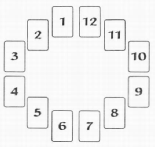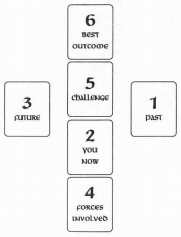All these things may belong in folklore, and have no bearing on the modern usage for runes; it is up to the individual to decide. One rune master I know draws three runes which represent current circumstances. Having looked at these three runes, he returns them to the pouch and draws three more. The second set of three represents courses of action or possible outcomes. The second set is then also returned to the pouch and a final single rune drawn, which indicates influences likely to have a bearing on the problem as a whole.
Tradition suggests that Odin's number was 5. For this reason, some rune masters work with only five runes. Those interested in numerology will note that the runes total 25 if you include the blank rune. This all adds up to 7, which is a powerful and spiritual number, and for this reason, perhaps, some rune masters draw seven runes when casting.
Another means of casting the runes is to ' shuffle them' and leave them to their own devices for a while (15 minutes is usually suggested), and then draw 12, laying them on a horoscope chart especially prepared for the purpose.
We have now briefly introduced ourselves to the runes, and are more aware of their foundation and usage. As already stated, more detailed descriptions of casting the runes will be given at a later stage. Before we are able to discuss each rune in sequence, we will look at the sort of runes to buy, and whether it is better to make your own set, and at the symbols.
Ways Of Casting The Runes
There are probably hundreds of different ways to lay the runes for a casting. What is given here is only a selection. It is by no means exhaustive.
I would suggest that you try some of these, going for the ones with which you feel comfortable before trying your own ideas out. The reasons for this are many, not least of which it is important to familiarize yourself with the runes and how they are read as a group before progressing.
It should also be remembered that you may have some personal thoughts on the meanings of the runes at the time you are carrying out the casting, which you should not dismiss out of hand. The meanings given in this book are basic, and again by no means exhaustive. You may for example wish to use all the reverse meanings given, even though some runes look the same either way up. Experience is the best teacher, and you must always do what you feel comfortable doing. Don't go along with something just because others do - make up your own mind.






